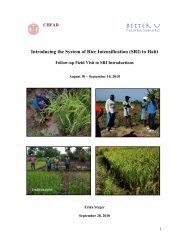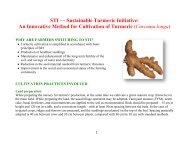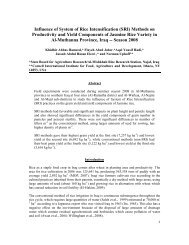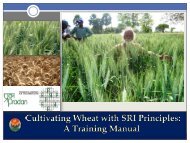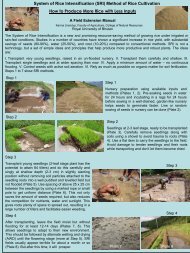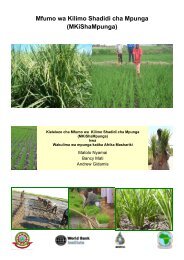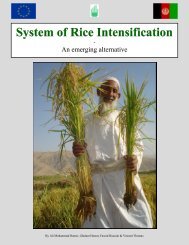EFFECT OF THE SYSTEM OF RICE INTENSIFICATION (SRI) ON ...
EFFECT OF THE SYSTEM OF RICE INTENSIFICATION (SRI) ON ...
EFFECT OF THE SYSTEM OF RICE INTENSIFICATION (SRI) ON ...
You also want an ePaper? Increase the reach of your titles
YUMPU automatically turns print PDFs into web optimized ePapers that Google loves.
t/ha<br />
5,5<br />
5<br />
4,5<br />
4<br />
3,5<br />
3<br />
2,5<br />
2<br />
1,5<br />
1<br />
0,5<br />
0<br />
2,19<br />
Rice yields 2008<br />
3,53<br />
Traditional <strong>SRI</strong><br />
Rice cropping systems<br />
Figure 14. Average rice yields for traditional and <strong>SRI</strong> farming systems from the crop season of 2008.<br />
In reality the yields are not per ha as none of the farmers grow <strong>SRI</strong> fields that large but they have<br />
been recalculated to t/ha as a more flexible way of comparing local yields with other yields from<br />
Cambodia and other countries. Assuming the reported yields by farmers are correct the difference is<br />
significant and similar to other comparisons examined by e.g. Caesay (2002); Yamah (2002); Stoop<br />
et al. (2002); Anthofer (2004) and Kabir & Uphoff (2007). Table 2 illustrates the yield differences<br />
as well between <strong>SRI</strong> and traditional grown rice.<br />
There was however no correlation between amount and type of amendments (incl. chemical<br />
fertilizers) and <strong>SRI</strong> yield nor between income and <strong>SRI</strong>. However it would have been expected that<br />
larger farmers (higher household incomes) would be able to invest in more chemical fertilizers and<br />
labour input and thereby increase yields.<br />
The only real difference between the farmers’ traditional field and <strong>SRI</strong> is then the use of only one<br />
seedling per hill with a wider spacing as water level and management was the same for the two<br />
systems. One seedling per hill with wider spacing is known by <strong>SRI</strong> supporters to increase the root<br />
growth, tiller and canopy development of young transplanted seedlings because the plant has more<br />
time and space to develop itself (Satyanarayana, 2004; Kabir & Uphoff, 2007;). Fewer roots per hill<br />
reduce the risk of root growth inhibition sometimes found when seedlings are transplanted several<br />
together (Satyanarayana et al., 2007). Larger root systems will then increase nutrient uptake (Kabir,<br />
55




